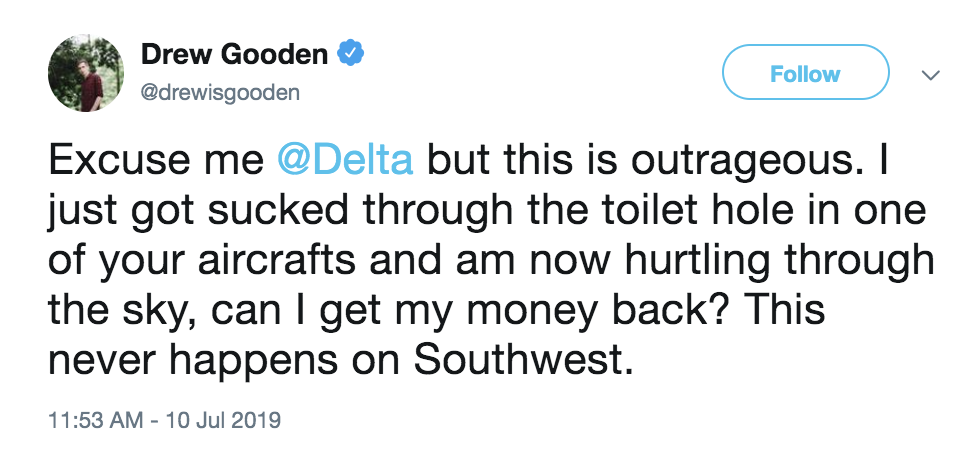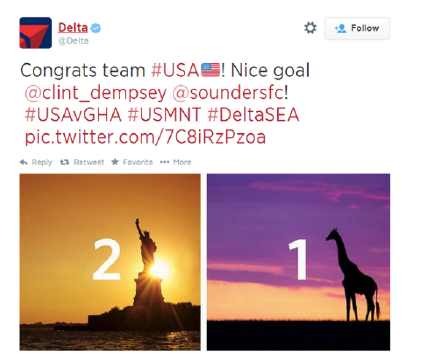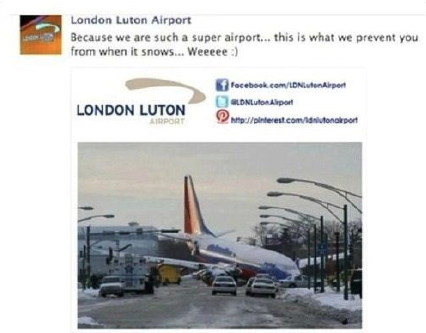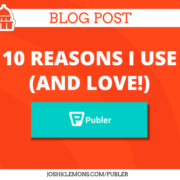7 Times The Airlines Blew It On Social Media (And What We Can Learn From Their Mistakes) | Step Up Your Social Ep 14
THE EPISODE
Audio:

THE TRANSCRIPT, ALONG WITH LINKS AND SCREENSHOTS:
Let’s take a step back and think about how this happened.
Now what the airlines lack in legroom, they more than make up for in social media budgets. Who amongst hasn’t used social media to reach out to an airline to complain about something, only to be met with a pseudo-personalized response — replete with an employee’s first name or initials — only to be informed they can’t actually help us with our problem but that they hope we have a nice flight (even though we’re writing to ask why our flight has been delayed 18 hours, with no end in sight!).
But still, they are paying people to monitor their channels, and provide quick responses to any and every query sent their way, including paying HBB to respond to Drew when he complains about being sucked out of one of their toilet holes.
What’s the lesson from this ridiculous exchange: social listening is good. But only, if you are actually hearing what your audience is saying.
Now this podcast exists to share quick, actionable tips to help you step up your social. In this episode, we’re going to look at 6 more times the airlines blew it on social media, and talk about what we can learn from their collective mistakes. Let’s let their fails become our best practices.
So without further ado:
Social Fail Number 2: The lesson here is the same as in the previous example, but it’s too good not to also share.
When American Airlines merged with US Airways, they created the world’s largest airline. Twitter user Mark Murphy tweeted his congrats. And this new mega-airline was quick to reply, thanking him for his support.
The problem: Mark’s congratulatory tweet actually read: “Congrats to @americanair and @usairways on creating the largest, shittiest airline in the world.”
So yeah, the airline was listening, but they weren’t actually hearing.
Social Fail Number 3: During the 2014 World Cup, the US was playing Ghana. When the US men’s team scored their second (game-winning) goal, Delta was excited to share the news with its fans. Smart. Delta serves an international audience of people who like to travel. Why wouldn’t they want to show their audience that they are in on the fun?
To represent the US, they used an image of the Statue of Liberty. To represent Ghana, they used an image of a giraffe. The problem? There are no giraffes in Ghana.
What can we learn from this mistake? Don’t make assumptions. Five minutes on Wikipedia could have prevented years of embarrassment for a brand that was trying to show they were with it, and instead showed how little they understood the world they were trying to connect.
In 2013, Luton Airport in London posted a photo of a recent incident from Chicago in which a plane had skidded of a runway, promising that “Because we are such a super airport… this is what we prevent you from when it snows… Weeeee :)”
Let’s start with the fact that this is just bad writing. But convulsion aside, the real problem with this post is that they were using a plane crash as a punchline, despite the fact that a six year old boy had died in the incident.
Even if your brand’s voice is bold and irreverent, know when it’s appropriate to make jokes about incidents involving dead kids? Umm, let’s go with never. Sound good?
For Social Fail Number 5: let’s start with the lesson and then move backwards. Contests and hashtags can be great ways to drum up User Generated Content and to encourage your audience to sing your praises to their communities. But they aren’t magic, and if you are struggling with a PR crisis, they can often create more harm than good.
This is a lesson that Qantas Airways learned the hard way.
Qantas wanted to drum up some online excitement for their brand, so they decided to give away a first class gift package by having people tell them about their “dream luxury inflight experience” using the hashtag #QantasLuxury.
The responses came streaming in. But they weren’t what Qantas had in mind.
Here are just a few examples:
- Getting from A to B without the plane being grounded or an engine catching fire
- #QantasLuxury is a massive executive bonus while your workers starve and your former customers choke
- Flights that leave on schedule because Management doesn’t arbitrarily shut down the airline #QantasLuxury
- #qantasluxury having a skybed so “superior in its class” you have to be under 5 foot to be able to use it with your legs straight.
- #qantasluxury – is not being told you can apply for refund online & finding out they only refund via a phone # that no one answers for 4hrs
So yeah, you get the idea.
This is not the story that Qantas wanted their audience to share with their networks. But even an intern should have foreseen that you can’t use a hashtag to solve a PR problem. A hashtag is offering the floor to your community. And if you think their stories MIGHT be more problematic than positive, maybe find another outreach approach.
Social Fail Number 6 was a famous one — United Airlines overbooked a flight and instead of raising the incentives until someone volunteered to leave the plane, they opted instead to violently drag a man — a doctor in fact — off of their plane. Someone shot a video of the brutal altercation and of course it went viral.
So I guess the lesson here is don’t be a jerk to your customers. But actually, I’m including this one on the list for a different reason.
As bad as the video was — and it was BAD — their real social media fail came from their response.
Bad things happen. An overzealous security guard or a stressed out flight attendant made a mistake and let their emotions get the better of them. Give it time and enough volume, it’s going to happen.
But when you inevitably make your apology, you better make it good. Needless to say, United blew that as well, or this issue wouldn’t have made today’s list.
A United exec put out a statement that essentially blamed the passenger, even though it was United who oversold the flight in the first place.
Additional apologies followed but it’s safe to say that this issue will stick with their brand for some time to come.
The lesson: if you are going to issue an apology, make it right the first time!
Which brings us to Social Fail Number 7, the final mistake on our list. This one is a doozy, and it’s — to put it mildly — NSFW (Not Suitable For Work).
In April, 2014, a Twitter user, Elle, tweeted her frustration with US Airways regarding an issue with her flight.
Five hours later, US Airways responded to let her know they were sorry.
Elle didn’t accept their apology. “Yeah, you seem so very sorry. So sorry, in fact, that you couldn’t be bothered to address my other tweets.”
US Airways responded with the following: “We welcome feedback, Elle. If your travel is complete, you can detail it here for review and follow-up.”
Accompanying this tweet was almost definitely the most explicit, shocking and inappropriate image every tweeted out by a Fortune 500 company, if not by any company ever!
It’s so NSFW I won’t even describe it here, other than to say it involved a toy airplane.
The tweet was deleted within an hour, but it is still very much lives on via screenshots all over the internet (even though I kinda wish it didn’t).
So here’s the lesson: don’t put anything on the internet, whether in a DM, a secret Facebook group or certainly not in response to a customer, if you aren’t prepared to see it quoted or screenshot across the internet.
Also, trust the people you have helping you manage your social accounts. Like, really.
Special thanks to Tre Temperilli for providing research assistance for this episode.
If you are enjoying this podcast, please consider leaving it a review wherever you stream podcasts. It will only take you a moment and can go a long way towards helping grow our audience.
Thank you and be smart out there.







Leave a Reply
Want to join the discussion?Feel free to contribute!